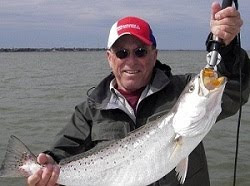What piece of equipment is often overlooked?
Maybe your landing net or an extra rod and reel.
Nope. Your sunglasses, prescription or non-prescription.
Aside from the obvious benefit of comfort, wearing sunglasses on a bright day can help protect your night vision; as well as help preserve the long-term health of your eyes.
Studies show that exposure to strong ultraviolet light will slow your eyes’ adaptation to the dark, meaning you might not have normal night vision until several hours after the sun sets.
Intense sun bleaches the chemicals out of your retina that you use for night vision. The chemicals do recharge, but it takes time, especially if your eyes have been exposed to strong light over a period of days.
Shielding your eyes from ultraviolet (UV) rays can also slow the development of cataracts, essentially a clouding of the lens. Cataracts are caused by a host of factors, including heredity and poor nutrition. Studies indicate long-term exposure to bright sun and glare can make folks already predisposed more susceptible.
UV Standards
You can hold a sunglass lens up to the sky to see how much visible light it factors out, but your dependant on the manufacturer’s work regarding the most important aspect of sunglass performance: filtration of UV light.
Ultraviolet rays are the invisible light rays that cause sunburns and can jump start skin cancer and cataracts. There are three types UVA, UVB and UVC. UVB has the potential for causing eye damage.
The American Academy of Ophthalmology recommends sunglasses that 99 percent to 100 percent of UV light. “UV absorption up to 400 mm,” a measure found on some labels, is the same thing as 100 percent UV absorption.
A wide variety of coating colors and types can also filter out UV rays. Glasses that don’t seem especially dark can still provide complete, or near complete UV protection.
Even sunglasses with 100 percent UV blocking can’t seal all UV light out. Moving a pair of standard sunglasses one-quarter inch away from the forehead increases UV exposure by 4 to 45 percent, depending on the design of the glasses.
Side panels will prevent light bleeding in the sides of your eyes, but depending on the shape of your face, you’re always going to have some bleeding at the top and bottom of the lenses.
Polarization
Polarized glasses are famous for letting you see structure just below the surface of the water and fish. Polarized lenses contain microscopic mesh to diffuse reflected glare. You get a lot less fatigue with a polarized lens. You do get a little less depth of field and contrast because of the way the light is diffused in the lens.
A higher price can buy you better optics and more durable frames. Fashionable colors and frames may also boost the price of a pair of shades, as do special features like polarization.
A quick test for lens distortion is to look through the glass at a straight, horizontal line. Turn your head from side-to-side. If the line seems to wobble and stretch, the lens quality is poor. Good quality sunglasses tend to have lenses made of either glass; a plastic called CR-39, or polycarbonate.
In general, glass is the most scratch resistant; plastics are lighter and more shatter resistant. CR-39 is naturally more scratch resistant than polycarbonate, which wins the impact-resistant category. Both CR-39 and polycarbonate lenses can be molded and polished to achieve a superior optical surface, neither is cheap, and CR-39 lenses tend to be expensive.
For those who still insist on tossing their glasses into the tackle box with the car keys, manufacturers have mixed up special ultra-hard coatings.
Remember, you have spent lots of dollars for fishing equipment. Don’t leave out the most important pieces the next time you go fishing. A good pair of quality sunglasses is essential and should be a part of your basic tackle.
See y’all on Galveston Bay.
Capt. Paul Marcaccio
